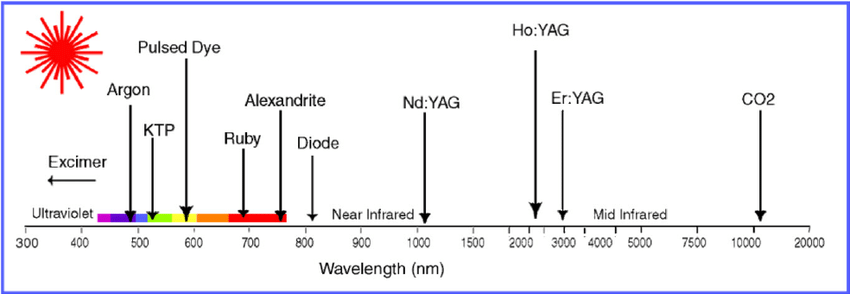I’m a big laser believer – I really think they are the wave of the future.
Let’s start with the basic notions
The laser (Optical Quantum Generator) is a device that converts the pump energy (light, electric, thermal, chemical, etc.) into the energy of a coherent, monochromatic, polarized and focused radiation flux.
In this article, we’ll speak about lasers with different wavelengths, their penetrating power, where and what for they are used.
The field of the laser application depends on its type. Today, there’s a great many of various lasers and this variety is timely growing.
- Gas lasers – gel-neon, krypton, nitrogen, excimer, hydrogen fluoride laser, etc.
- Dye lasers
- Metal vapor lasers – helium-cadmium, mercury-gel, gold pore laser, etc.
- Solid-state lasers – ruby laser, neodymium glass laser, titanium-sapphire laser, erbium-doped fiber laser, etc.
- Semiconductor lasers
And other types of lasers such as color-center lasers, free-electron lasers, and pseudo-nickel-samarium lasers.
The field of laser application is also very wide.
Here are some examples:
- Lasers in the industry for engraving, cutting, surface processing, lithography, welding, etc.
- Lasers in medicine for surgery, diagnostics, vision correction, hair and tattoo removal, dermatology, dentistry, etc.
- Lasers for information storage used in CD, DVD, Blue-Ray, magneto-optical discs, holography.
- Lasers in communication for fiber optical communication, satellite communication.
- Laser imaging – laser projection displays.
- Laser spectroscopy – in physics (pollution monitoring), biology, medicine (for cancer diagnostics).
- Laser microscopy.
- Lasers in sciences – laser cooling, laser guide stars, capture and manipulation of small particles, etc.
- Military lasers.
Lasers play an important role in materials processing. The laser energy transforms materials when interacts with them. To do this it is necessary to set such parameters as a wavelength, power, pulse rate.
These lasers processes include
- Laser annealing
- Laser cutting
- Laser drilling
- Laser engraving
- Laser marking
- Laser perforation
- Laser photoengraving
Let’s have a closer look at the setting of a laser wavelength and where lasers with different wavelengths are used. The wavelength is the distance between two closest points in space at which vibrations occur in the same phase.
Diode lasers with a wavelength of 405 nm:
The laser module AP-LDN-R-0405 is a diode laser ideal for the applications when UV light with a wavelength of 405 nm and continuous output power up to 500 mW are needed. These lasers are widely used to evoke fluorescence, for flow cytometry, spectral analysis, and other purposes. This 405nm wavelength is very popular due to its use in Blue-ray devices and optic discs. Other spheres of application include UV therapy and examination. For example, photoinactivation of bacteria with visible light was reported in many studies.
The antimicrobial effect of lasers is studied.
The 405 nm diode laser is used in the treatment of soft tissues. (https://www.researchgate.net/publication/229666415_Surgical_performance_of_a_405-nm_diode_laser_in_treatment_of_Soft_tissue ).
The 405 nm diode laser is also known for titanium oxide bleaching activation. (https://www.researchgate.net/publication/274623597_Effects_of_405_nm_Diode_Laser_on_Titanium_Oxide_Bleaching_Activation )
Diode lasers with a wavelength of 445 nm:
Another module AP-PGLY-H-0445 is a diode laser ideal for purposes requiring blue light with a wavelength of 445 nm and continuous output power up to 1000 mW. These lasers are widely used for lighting, laser show, etc.
The semiconductor diode laser with a wavelength of 445 nm is used for efficient cutting of soft tissues. (https://www.researchgate.net/publication/319629934_Efficiency_of_soft_tissue_incision_with_a_novel_445-nm_semiconductor_laser).
Fluoride treatment and 445 nm laser irradiation help dental enamel solidification. (https://www.researchgate.net/publication/337009425_Artificial_Caries_Resistance_in_Enamel_after_Topical_Fluoride_Treatment_and_445_nm_Laser_Irradiation?_sg=IN0JKjT0_8Qf5xXXbybjJXa47qjO9Ls2OMKbBLLjVJrWVL14-0a0WeuqQv_TvmxP85EffZqP1D8q-Oc).
Researchers study the laser action on the BX band of Hgl at 445 nm. (https://www.researchgate.net/publication/252856005_Laser_action_on_the_BX_band_of_HgI_at_445_nm).
Diode lasers with a wavelength of 445 nm for material processing. https://www.researchgate.net/publication/317357835_Development_of_a_high-power_blue_laser_445_nm_for_material_processing
Below there is a number of references concerning studies of the 535 nm laser action on various materials, such as thallium line; https://www.researchgate.net/publication/231077487_Pressure_effects_of_krypton_and_xenon_on_the_535_nm_thallium_line
in a mixture of calcium and thallium vapors; https://www.researchgate.net/publication/243375728_Superradiance_at_a_wavelength_of_535_nm_in_a_mixture_of_calcium_and_thallium_vapors).
The photophysical properties of He-related color centers in diamonds are studied. https://www.researchgate.net/publication/319350235_Photo-physical_properties_of_He-related_color_centers_in_diamond).
Diode lasers with a wavelength of 808 nm:
The temperature characteristic in vertical-cavity surface-emitting lasers (VCSELs) is studied as it directly affects on the photo-electricity characteristics of semiconductor lasers.
(https://www.researchgate.net/publication/300330805_808_nm_VCSELs_Temperature_Characteristic_Study).
The effect of a Multiwave Locked System laser (with a simultaneous 808 nm continuous emission and 905 nm pulse emission) on the spinal cord after spinal cord injury (SCI) in rats is investigated.
This study verifies the effectiveness and safety of the 808-nm wavelength for the treatment of benign lesions of the oral cavity that are stained with a toluidine blue solution.
808 nm-light-excited lanthanide (Ln(3+) )-doped nanoparticles (LnNPs) hold great promise for a wide range of applications, including bioimaging diagnosis and anticancer therapy.
Diode lasers with a wavelength of 1064 nm:
Lasers with a wavelength of 1064 nm are proved to be effective and safe tools for hair removal in any skin type.
(https://www.researchgate.net/publication/272048546_Long-Pulsed_1064-nm_Nd).
A high‐resolution, acoustic resolution photoacoustic microscopy (AR‐PAM) system in the near infra‐red (NIR) window II (NIR‐II, e.g., 1064 nm) for deep tissue imaging is developed.
The use of 1064 nm Nd:YAG laser as a therapeutic modality for BCC (basal cell carcinoma) is an alternative to patients who refuse surgery, have multiple co‐morbidities, or decline non‐surgical therapies
The first laser (GLAS has 3 lasers) was turned on and GLAS began obtaining atmospheric and surface returns at 1064 nm.
The range of laser applications is very wide due to their properties such as coherence, monochromacy, high power density. The use of the laser beam enables to get unique results. Lasers have expanded our abilities in various fields: metal processing, medicine, measuring and control operations, physical, chemical, biological studies, etc. The development of new, more advanced and endurable laser models goes on. Lasers are, no doubt, the wave of the future.
